LOS Origins
Business Computers Limited
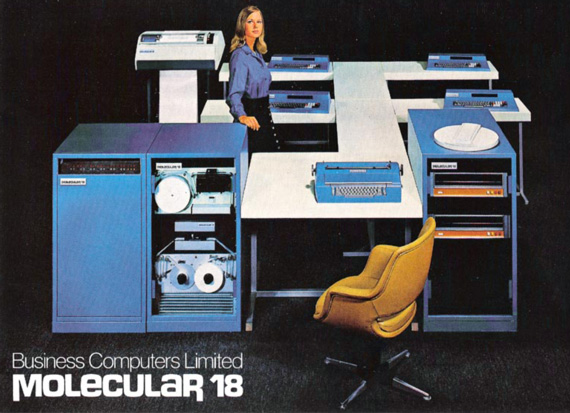
BCL Molecular Mark 1 (click on a component to view its technical details sheet)
In addition to Wikipedia, an overview of the various incarnations of Business Computers and the Molecular 18 mini-computer has been compiled by the Computer Conservation Society. Kevin Murrell has a website with several items relating to Business Computers, including two informative profiles of the original company as at 1968 and 1969.
The content of this website relates to software used on the Molecular 18 range of mini-computers (excluding the Mark Two) from 1975. By this time BCL had developed the Molecular-18 (Marks One and Two) mini-computers at their Brighton factory following the success of their SADIE and SUSIE accounting machines but the company called in the receiver in 1974.
An agreement between the receiver and the computer maintenance and broking group Computer World Trade enabled all aspects of the business essential to existing BCL users to continue operating, but this put a stop to all further development. Thus when I joined BCL's Leicester branch office in May 1975 the branch offices were supporting the Molecular Mark One installations in their area whilst Brighton handled any Mark Two support. This was an ideal environment to gain familiarity with the machine and its use, and a sharp contrast to my previous experience in the rarefied corporate environment of IBM Sytem 360 and System 370 installations. Instead of sending off coding sheets to be punched onto 80-column cards, here we flicked each binary digit from our hand-written coding sheet into core memory standing at the control panel and users sat at keyboards equipped with an eight-character display (there was a backspace key but it did not correct a typing error). This may seem primitive, but the Mark One had effective software packages for sales ledger, bought ledger, nominal ledger and payroll which could run on an "entry level" Mark One (one package at a time, in 8K 17-bit words of core memory and a 2½ Mb removable disc cartridge). The applications software was founded on a collection of memory-resident subroutines known as the Firmware providing basic housekeeping, arithmetic, input/output and interrupt handling facilities. The Firmware mostly occupied Pages 01 to 04, much of which endured throughout the lifetime of LOS. BCL's Serial Printer was a noteworthy contraption with two sets of tractors for two types of continuous stationery side-by-side with one dot-matrix print head running across the two. Thus the payroll package printed payslips and cheques simultaneously (however BCL did not use its payroll package for its own employees).
For installations with more than one keyboard (and at least 12K words of core memory) the BCL Supervisor could be loaded above the Firmware (into Page 13). The Supervisor scheduled CPU time between multiple Routes (renamed Tasks in LOS), though each keyboard required its own version for its own reserved memory area.
There was, however, nothing firm about the Firmware: once booted into core from disc it was as vulnerable to corruption by errant software as any other core location.
Art and Automation
From DATA SYSTEMS Magazine (February 1977)
One of the most important activities of the Tate Gallery, representing an annual turnover of half a million pounds, is its sales of reproductions of its art collection. The problems of stock control and accounting became so great that the Gallery has now installed a small business system.
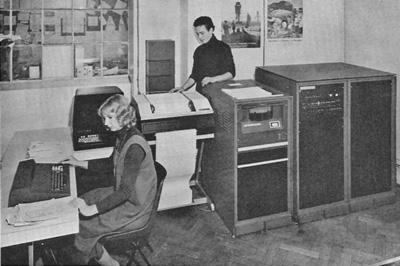
BCL Molecular 18 Mark III installed in the Tate Gallery
A typical example of a direct entry mini computer system which provides sales accounting and stock control routines and with the facility for on-line enquiries is the BCL MOLECULAR computer in the Publications Department of the Tate Gallery.
The upsurge of public interest in art has resulted in an extensive business being built up in the sales of reproductions of the vast art collection administered by the Tate. The Publications Department generates an annual turnover of £500,000 from over 2,500 different products which are distributed throughout the UK and overseas.
To ensure effective stock control of their 2,500 different product lines and efficient sales accounting procedures they use a MOLECULAR minicomputer system supplied by Business Computers (Systems) Limited, which consists of a 12K words central processor, alpha numeric display keyboard, 200 lpm printer, visual display terminal and 5 million characters of disc storage and is basically designed to cater for a wide range of accounting functions, stock control and generation of sales and management reports.
The products marketed by the Tate fall into 12 main groups and range from framed reproductions, reference books and exhibition catalogues, to photographic slides and art post cards. More than one million of these post cards are supplied each year to the Tate’s 500 account customers, through the retail shop housed within the Gallery, and by mail order to overseas.
Supplies of stocks are held at two locations, a bulk warehouse in Cambridgeshire and in a large in-house stock room to meet day to day requirements. Customer account details, product information and stock levels, detailing separate levels for the two locations, are held on disc files.
Order data is input to the system through the keyboard or the VDU, although the latter in this instance is mainly used for customer account and stock interrogation. Under program control, the keyboard operator is guided through each step of invoicing procedure, thus reducing the possibility of errors.
Relevant customer details are entered, quantity of items required and the system completes the invoice line showing total value and VAT. Four price categories, cost, retail, trade and educational for each stock item are catered for within the system.
Stock is immediately updated on completion of each invoice line thus providing up to the minute stock accuracy to satisfy customer telephone enquiries. If, however, the invoice is cancelled for any reason, stocks are immediately returned to their correct levels. The flexibility of the system allows invoices to be printed as a simultaneous operation of keyboard input or, if the printer is being used for report production, spooled on disc for later processing. During invoice printout customer balances, master files by product group, customer sales by product group and profit by product group, are automatically updated.
On-line enquiries, such as stock levels and customer account details showing current balance and aged debt analysis over thirty, sixty and ninety days can be carried out without interrupting the progress of other work systems being processed by the installation.
Batch reports and cash posting are carried out daily. Cash posted to customer accounts is allocated to the relevant aged debt category and balances updated. A variety of reports are catered for to provide vital sales statistics.
Aged debt analysis reports for distribution to key departments are produced on a regular basis to ensure efficient cash flow.
The system which was operational within one week of installation uses standard BCL software, although modifications have been implemented in-house by Mr Mark Adams, computer controller at the Tate. These include refinements to ease the task of producing repetitive invoices which result from volume requests for catalogues during an exhibition of national appeal.
Previously a BCL Susie accounting machine was used but as work loads increased this was replaced by the Molecular system which is capable of expansion with the addition of peripherals and added processor capacity to meet future business expansion without changing hardware or software.
“We chose the system” said Mr Brian McGahan the department assistant Manager, “because of its ease of operation and capabilities for future expansion, should these be required by increased workloads. The direct entry and on-line enquiry facilities provided by the system are ideal for our operation and allow us to maintain stock at optimum levels and keep rigid control of our cash flow position which is vital in these days of high interest rates”.
Comments
The Tate Gallery installation was the final step before LOS.
An earlier installation for C Victor Ltd (a swimwear manufacturer in St. Albans) was the start but it certainly wasn’t LOS. Its foundation was the BCL Supervisor. This was a task scheduler sitting on top of the Mark I “firmware” (a collection of subroutines for arithmetic, data conversion and input/output) with a gap in between where you could put the application code. With the BCL Supervisor, we had to set out separate memory space for each task, and then write a separate version of every program for each task that might run it. We didn’t solve that problem with C Victor, rather it drew attention to the need to find a solution whilst we attended to other more pressing matters, such as typing in a program at the keyboard rather than flicking it in bit by bit through the control panel switch register, and setting up a file structure instead of working with the absolute sector numbers on the discs. C Victor's 300 bps 80-column by 8-line VDUs were certainly a novelty (what could that key marked Escape be for?), and Janet (their Supervisor) gained the admiration of her colleagues for continuing to work at hers during a thunderstorm.
Next came the Tate Gallery installation described above. This was the first place where we used offset addressing to run the same program code in any task partition. Mark Adams rewrote all the applications software to run under LOS as soon as it became available.
Maggie arrives (and gives birth to LOS)
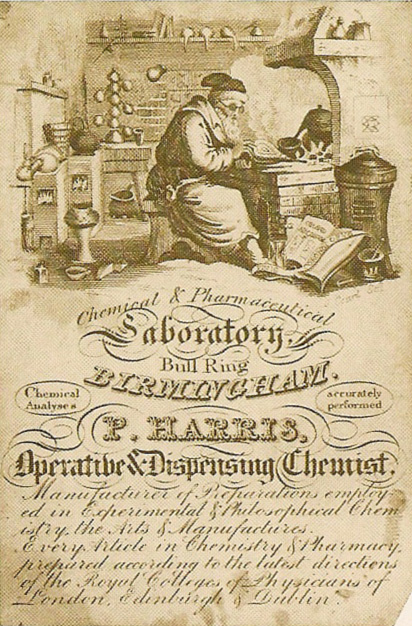
Philip Harris Medical Ltd. (of Birmingham) took delivery of their Molecular around the time Margaret Thatcher was establishing herself as Leader of the Opposition so it was promptly named Maggie. Here indeed was an Iron Maiden, and painted blue. There were to be six VDUs (four for the telesales office) and two printers (one for directly printing invoices in the warehouse). After some weeks while we developed the programs at Leicester and PH checked them out very thoroughly and prepared themselves, LOS was born when PH opened for business, live on Maggie on the first Monday of November in that year (1976).
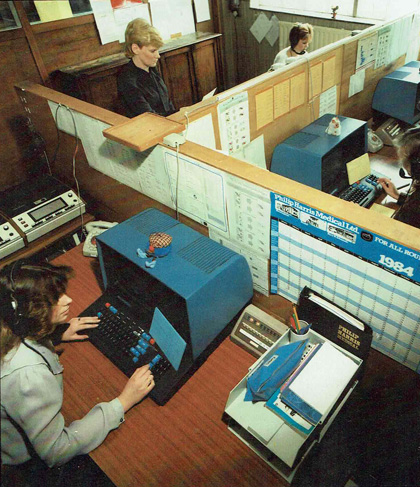
Anne McGrory and myself were in attendance from BCL with Kath Hodges, Mr. Ruston (PH's Managing Director) and other managers standing by behind the telesales girls as they began their calling rota. It was a revelation! No Molecular had ever had the opportunity to show but a fraction of what it could do until that morning. I went through to watch Maggie. Yes, her lights were flickering. Instructions were being fetched and executed, for a real purpose now. Interrupts were being taken from all quarters and dismissed methodically. Drive belts were staying on and propelling the disc cartridges at the proper speed and the head access mechanisms were wild with frenzied yet directed activity. Power supplies were pumping energy at the correct voltages into the circuits. Down in the warehouse the printer was disgorging real invoices, the shelves were being picked of goods and the delivery vans were rolling. How long could it last?* To me, every extra second was another million or so crash possibilities negotiated. There are advantages, in this situation, in not being aware of what could go wrong. So my frequent calls to Kath to “take a security” were cast aside until things quietened down at lunchtime. I could relax a bit after we’d secured the mornings work.
As other companies were to discover in their turn, the whole atmosphere of the business was transformed the instant their Molecular went into action. It was there to help, not to intimidate. This atmosphere was subtle but tangible whenever I entered a building containing one of these systems. Mind you, a certain tool distributor did keep their entire stock of sledgehammers just outside the door to their Molecular - just in case.
A significant component missing from LOS on that first day was any means to deal with a paper wreck at the invoice printer. This was because I didn’t have a clue how the situation could be handled, until it happened. That occurred soon enough, and the document reprinting utility was soon operational.
* the answer came on the third day when the processor's power supply became erratic, causing crashes necessitating reboot. The engineer called to fix this did not have a replacement power unit but did have a bright idea - why not swap the processor's power unit with one from one of the disc drives'? Well, that stopped the crashes but it soon became apparent that data was being incorrectly written to disc, a much worse situation requiring recovery from security copies.
Maggie and Denis in 1990
By 1990 Maggie was bulging with the maximum 64K words of memory and the interfaces to serve 17 VDUs and 5 printers, and now backed up by a second Molecular (named Denis, after Mr. Thatcher). Even though the processor still ran at the same speed as in 1976, no realistic UNIX alternative could yet match the performance of the machine code applications software. However, hardware breakdowns were a constant anxiety which Denis could only partially mitigate, so a reliable UNIX alternative was being sought. It became a close race as to which of the two Maggies would outlast the other in office. In the end, Maggie the Molecular had a narrowly longer run.
Though Maggie's electronic circuits remained 1970s technology, and her on-line storage capacity never rose above the original 13 megabytes, the emergence of microcomputers (followed by Personal Computers or PCs) in the 1980s provided her a lifeline to capabilities she could not hope to offer unaided. Plugging one of these into her in place of a "dumb" VDU enabled her to transfer data with the emerging networks, to download to high-capacity archival storage, and even gave her an accurate clock.
Postscript: Kath's reflections on "Maggie the marvelous computer"
As some of you [at Philip Harris] know we have just purchased yet another state of the art computer, to cope with our rapidly expanding business. This one, extremely powerful and with massive amounts of disc space and memory, is a far cry from Maggie, our very first in-house computer.
When I joined the medical company it had no computer, in fact very few businesses owned one in those days. Computer bureaus were the big things then and a bureau ran our very first system. Orders were handwritten, picked and then the dockets sent back upstairs to be connected to punch tape which was sent off each Friday evening to Mills of Monmouth, who then returned it to us on Monday morning as invoices. This may seem primitive now, but for Philip Harris Medical it was a giant leap forward as until then all invoices were typed, pricing was done by means of metal plates and a Bradmar System and they were then "comped up". This was a laborious task and work was always late, copy invoices had to be then sent to head office for statements to be produced, these always went out at least one month late and it was often two. All credit notes were hand-written in immaculate copperplate by a gentleman called Pryce Jones and as you can imagine it could be a few weeks before a customer received his credit note. (Now they want them yesterday!). The bureau system was such an improvement on all this that Mr Ruston, who was then our managing director and Mr Linney, who was sales director, decided to buy a computer of our own and the hunt was on. After many site visits and much discussion we decided on a BCL Molecular and Maggie was born.
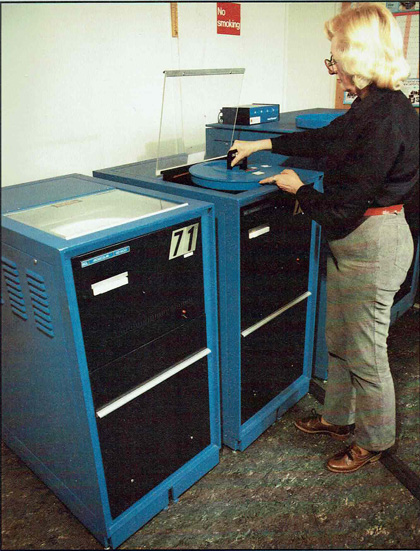
She consisted of a large metal box with a row of switches topped by twinkling lights and two large disc drives which each had a fixed and top-loading removable disc. The whole thing was painted true Tory blue and as this machine had a mind of its own and the Russians had just christened Mrs Thatcher the "Iron Lady" its name just had to be Maggie. The box contained only 40k of memory to start with the rest were filled with air! The disc drives each had one 3.5meg fixed disc and one 3.5meg removable disc, unbelievable these days when even the smallest laptop has much more than this. The person in charge of designing the system was Chris Green, then of BCL, now our chief programmer and well known to many of you. The operating system and most of the programs were written by Joe Templeman, who you also see around from time to time, as he designed and wrote our Worm system and also our Alpha I ordering system. Maggie's programs were all written in machine code, which made her response times very fast indeed and the disc drives were using a very modern concept of mirroring, designed by Joe, which meant that in the event of a drive failure, (and we had many) the faulty one could be taken out of the system and we could continue working on the other.
Although Maggie was marvelous and the business began to expand it was not all plain sailing. Computers in those days were not as reliable as their modern counterparts and Maggie was very susceptible to "blips" in the power supply and also to static, quite a bit generated by VDU operators who wore nylon underwear! Static would lock all the VDUs and Joe wrote a special program called "kick" which I typed in to start them all off again. Far more serious was a sudden surge or drop in the power supply, which could stop the processor.
The row of lights above the switches was a clear indicator of Maggie's health and if they were all twinkling merrily she was happy and working. I used to dread the moment when there was a cry from the sales office, then from upstairs to say that they had all stopped and on dashing into the computer room I would find that the lights had stopped twinkling and had changed their pattern. The first move was to "bootstrap" the processor, using the switches this was quite a complicated procedure and if you got one of the steps wrong you had to go back to the beginning and start again. I used to press the "start" switch at the end holding my breath and praying that it would. If it didn't, I then had to call a programmer and he would attempt to correct the fault, if this proved impossible I then had to call the engineers, while the computer was down we had to return to manual working, and all orders had to be coded with bin numbers taken from the print outs, a laborious task. They were then sent down to the warehouse by means of Lamson-Paragon tubes, which were a series of large metal pipes running around the building and glass document carriers which held the orders. They were then placed in the tubes and sent round the warehouse by compressed air. This worked fine until a carrier would get stuck somewhere on its journey and then all hell was let loose. We had to have a "runner" who would tear up and down the stairs with the orders and although one no-one actually dropped dead while acting as runner it was a close run thing once or twice!
As the business expanded the effect of a breakdown became more and more horrendous. We purchased another smaller Molecular as back up for Maggie, which was housed downstairs in what is now the visitor's toilet. We copied Maggie's data onto the two security discs at 1 o'clock and 5 o'clock and these were carried down and copied onto the back-up, christened Dennis, by means of a patch panel on the wall and a set of cables and plugs. Although this enabled us to carry on working it created problems of its own, as Dennis was only valid up to the last security and if Maggie decided to throw a wobbly at about 12.30 which she invariably did, it meant that a whole morning's work had disappeared down a black hole! A small team of people would determine what the first and last invoice numbers were (after security and pre-Dennis) and then run round the warehouse finding them all and putting them into number order, ready for re-entry when Maggie was up and running again. This also applied to credit notes, cash postings, stock adjusts, goods loaded and purchase invoice postings, all had to be done again once the computer was up and running. Maggie also had a nasty habit of breaking down just after stocktaking, screwing up the newly counted and adjusted stock figures, which didn't exactly make her popular with the auditors. On one classic occasion we had three breakdowns in the first week after stocktake and had to do it again the following month. Because we were so busy and the business was so dependant on the computer to get the work out on time, when Maggie broke down there was a constant stream of people in and out of the computer room asking how long it would be out of action and how the engineers were getting on which didn't exactly please them, and as one or two of them burned on rather a short fuse I used to try and shoo everyone out of the room as quickly as possible. I'm sure that the engineers dreaded a call from us as much as I dreaded having to make one.
In spite of Maggie's temperamental nature she lasted for fourteen years and BCL used us as a showcase selling many systems based on ours. When the time came to replace her we found that it was impossible to equal her response time with a modern system, although of course they were much more reliable and could offer much more in the way of programs. Our present system has been re-written many times to accommodate our expanding business but it was Maggie that started it all. Thanks to the foresight of Mr Ruston and Mr Linney in choosing a system so far ahead of its time, Philip Harris Medical was dragged kicking and screaming into the 20th century and has never looked back.
Kath Hodges (Stirchley) c1995.
